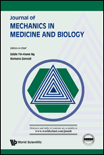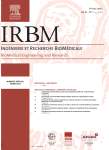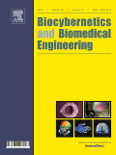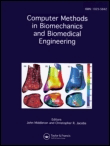
Journal of Mechanics in Medicine and Biology
Scope & Guideline
Transforming Medical Technologies through Mechanical Research
Introduction
Aims and Scopes
- Biomechanics and Rehabilitation Engineering:
Research in this area includes the design and evaluation of rehabilitation devices, such as exoskeletons and robotic systems, aimed at improving patient recovery and mobility. - Medical Imaging and Image Processing:
This encompasses advanced methodologies for medical image analysis, including segmentation and classification techniques using deep learning and other computational methods. - Computational Modeling and Simulation:
The journal features studies that utilize computational fluid dynamics (CFD) and finite element analysis (FEA) to model physiological systems, assess medical devices, and predict treatment outcomes. - Health Monitoring and Wearable Technologies:
Research focusing on the development of wearable devices that monitor physiological signals, aiming to enhance patient care and provide real-time health assessments. - Artificial Intelligence in Healthcare:
This includes the application of machine learning and AI techniques to improve diagnosis, treatment planning, and patient management through data-driven approaches. - Clinical Applications of Biomechanics:
Studies that investigate the biomechanical factors affecting clinical outcomes in various medical conditions, such as musculoskeletal disorders and surgical interventions.
Trending and Emerging
- Deep Learning and AI Applications:
There is a marked increase in research utilizing deep learning algorithms for tasks such as image segmentation, diagnosis, and predictive modeling, showcasing the growing reliance on artificial intelligence in medical applications. - Robotics and Autonomous Systems in Healthcare:
Emerging studies focus on the development of robotic systems for rehabilitation and surgery, indicating a trend towards automation and enhanced precision in medical interventions. - Multimodal Health Monitoring Systems:
Research on integrated systems that combine various physiological monitoring techniques using IoT and wearable devices is gaining traction, reflecting a shift towards comprehensive patient health management. - Personalized Medicine and Customized Treatment Solutions:
The journal is increasingly publishing studies on personalized approaches to treatment, including custom implants and individualized rehabilitation protocols, driven by advancements in biomaterials and patient-specific modeling. - Simulation-Based Medical Training and Planning:
Emerging themes include the use of simulation and virtual reality for training healthcare professionals and planning surgical interventions, indicating a trend towards enhanced educational tools in the medical field.
Declining or Waning
- Traditional Medical Practices:
Research related to traditional methods such as acupuncture and herbal medicine appears to be declining, possibly due to a growing emphasis on evidence-based practices and technology-driven approaches. - Simple Mechanical Devices:
The focus on basic mechanical devices or traditional rehabilitation tools is waning, as the trend shifts towards more sophisticated, technology-enhanced solutions like robotic systems. - Basic Physiology Studies:
There is a noticeable decrease in the publication of basic physiological studies that do not incorporate advanced modeling or technology, indicating a preference for interdisciplinary applications that combine engineering and biological sciences.
Similar Journals

Biomedical Engineering Letters
Advancing biomedical innovation through shared knowledge.Biomedical Engineering Letters, published by SpringerNature, is a prominent journal in the field of Biomedical Engineering. With a robust ISSN of 2093-9868 and E-ISSN of 2093-985X, this esteemed journal has established itself as a vital resource for researchers and professionals seeking to advance their knowledge and share groundbreaking findings. Recognized for its quality, Biomedical Engineering Letters holds a distinguished ranking in Scopus, positioned at #94/303 (69th percentile) in the Biomedical Engineering category. The journal covers a diverse scope within biomedical engineering, providing an important platform for innovative research from 2011 to 2024 and facilitating the exchange of ideas among scholars. Although it operates under a subscription model, the journal's commitment to enhancing the field makes it an indispensable reference for those engaged in cutting-edge biomedical research in Germany and globally.

IEEE Open Journal of Engineering in Medicine and Biology
Unlocking the potential of interdisciplinary research.IEEE Open Journal of Engineering in Medicine and Biology is a premier Open Access journal published by the esteemed IEEE-INST ELECTRICAL ELECTRONICS ENGINEERS INC, dedicated to advancing the interdisciplinary fields of biomedical engineering and medicine. Since its inception in 2020, the journal has quickly established itself within the academic community, boasting a notable ranking of #49 out of 303 in the Biomedical Engineering category on Scopus and achieving an impressive 83rd percentile. With an objective of disseminating high-quality research and innovative developments that bridge engineering and medical sciences, the journal is committed to fostering collaboration among researchers, healthcare professionals, and policymakers. Operating with Open Access since 2020 allows for wider accessibility and dissemination of cutting-edge findings, promoting the exchange of knowledge vital for tackling contemporary challenges in health technology. As the journal continues to grow through to 2024, it remains a vital resource for anyone invested in the enhancement of medical technology and the betterment of patient care.

Biomedical Engineering Online
Empowering research at the intersection of engineering and medicine.Biomedical Engineering Online, published by BMC, is an esteemed open-access journal in the United Kingdom that has been advancing the field of biomedical engineering since its inception in 2002. With a commitment to disseminating high-quality research, the journal encompasses a broad scope, including innovative studies in biomaterials, imaging technologies, and medical applications. Recognized within the Q2 quartile for various categories such as Biomaterials and Biomedical Engineering, it ranks favorably among its peers: Rank #58 out of 333 in Radiology, and Rank #15 out of 63 in Radiological and Ultrasound Technology in the Scopus database. These rankings, coupled with an open-access model, ensure that critical advancements in medical technology are accessible to researchers, health professionals, and students globally. As it continues through its converged years from 2002 to 2024, Biomedical Engineering Online remains an invaluable resource for anyone involved in the cutting-edge intersection of engineering and medicine.

Cardiovascular Engineering and Technology
Innovating the Future of Cardiovascular HealthCardiovascular Engineering and Technology, published by SPRINGER, stands as a prominent journal in the fields of Biomedical Engineering and Cardiology. With an ISSN of 1869-408X, this journal bridges the gap between engineering innovation and cardiovascular health by exploring the latest advancements pertinent to cardiovascular technologies and therapies. The journal, currently in its converged years from 2010 to 2024, holds important positions in Quartile 3 of both Biomedical Engineering and Cardiology and Cardiovascular Medicine categories, highlighting its relevance and influence in these domains. Ranked in the 59th percentile for Cardiology and 42nd percentile for Biomedical Engineering, the journal is a valuable resource for researchers, professionals, and students keen on understanding the intersection of engineering solutions and cardiovascular medicine. Although the journal is not open access, it remains highly regarded for its rigorous peer-reviewed content that contributes to the advancement of technology in the cardiovascular field.

Bioengineering-Basel
Exploring the Future of BioengineeringBioengineering-Basel, an esteemed journal published by MDPI, stands at the forefront of innovation in the field of bioengineering since its inception in 2014. With an E-ISSN of 2306-5354, this fully Open Access journal based in Switzerland provides a platform for researchers and professionals to disseminate cutting-edge findings across various aspects of bioengineering, including biomaterials, tissue engineering, and biopharmaceuticals. The journal has been recognized with a Q3 ranking in the 2023 Bioengineering category, reflecting its commitment to quality and relevance. By facilitating widespread accessibility to academic knowledge, Bioengineering-Basel aims to foster collaboration and stimulate thought leadership within the global research community, making it an indispensable resource for students, scholars, and industry practitioners alike.

IRBM
Fostering Collaboration for Groundbreaking Scientific InsightsIRBM, published by Elsevier Science Inc, stands at the forefront of research in the domains of Biomedical Engineering and Biophysics, boasting impressively high rankings with a Q1 category in both fields according to the 2023 evaluations. With an effective focus on cutting-edge innovations and methodologies, IRBM provides a vital platform for researchers, professionals, and students alike seeking to disseminate and access groundbreaking findings and developments. Its strong presence in the Scopus database, with ranks of #12 in Biochemistry, Genetics and Molecular Biology and #42 in Biomedical Engineering, places it in the top percentile of impactful journals in the field, making it a crucial resource for advancing knowledge and fostering collaboration. While the journal maintains a traditional subscription model, it continues to attract a diverse readership eager for insightful studies and reviews that push the boundaries of science and engineering. With a projected convergence of years extending to 2024, IRBM promises to remain a significant contributor to the ongoing dialogue in the life sciences.

Biocybernetics and Biomedical Engineering
Leading the Charge in Biocybernetic ResearchBiocybernetics and Biomedical Engineering, published by ELSEVIER in the Netherlands, is a prestigious journal that stands at the forefront of the intersecting fields of biomedical engineering and artificial intelligence. With an impressive Impact Factor that places it in the Q1 category for Biomedical Engineering, this journal not only ranks 17th out of 303 in Scopus but also boasts a remarkable percentile ranking of 94th, highlighting its influence and relevance within the scientific community. Since its inception in 2008, Biocybernetics and Biomedical Engineering has aimed to publish cutting-edge research that integrates principles of cybernetics with technological advancements in health care, thereby fostering innovations that improve patient outcomes. Dedicated to advancing knowledge in biomedical technology, the journal serves as a vital resource for researchers, professionals, and students seeking to explore the latest developments and methodologies in the field.

PROCEEDINGS OF THE INSTITUTION OF MECHANICAL ENGINEERS PART H-JOURNAL OF ENGINEERING IN MEDICINE
Exploring Synergies: Engineering Solutions for Medical ChallengesProceedings of the Institution of Mechanical Engineers Part H - Journal of Engineering in Medicine is a pivotal publication in the interdisciplinary realm of mechanical engineering and medical technology. Published by SAGE Publications Ltd, this esteemed journal delivers cutting-edge research and innovative solutions that bridge the gap between engineering principles and medical applications. With an impressive reputation, the journal is ranked in the Q2 category for Mechanical Engineering and Q3 for miscellaneous Medicine in 2023, reflecting its significant contribution to the field. Boasting an impact factor that positions it favorably in both mechanical engineering and medical research, it serves as a critical platform for researchers, professionals, and students eager to advance their knowledge and influence the future of engineering in healthcare. This journal encompasses diverse topics, driving forward the synergy between engineering and medicine while promoting discussions and discoveries that shape industry practices globally.

COMPUTER METHODS IN BIOMECHANICS AND BIOMEDICAL ENGINEERING
Exploring the Intersection of Technology and Human MovementCOMPUTER METHODS IN BIOMECHANICS AND BIOMEDICAL ENGINEERING, published by TAYLOR & FRANCIS LTD, is a leading journal dedicated to the interdisciplinary field of biomechanics and biomedical engineering. With an ISSN of 1025-5842 and an E-ISSN of 1476-8259, this journal has been a significant resource since its inception in 1997 and will continue to publish cutting-edge research until 2024. The journal holds a respectable position in the academic community, categorized in Q3 of multiple domains including Bioengineering, Biomedical Engineering, and Human-Computer Interaction, reflecting its relevance across diverse fields. Although the journal does not offer open access, it provides valuable insights and methodologies essential for researchers, professionals, and students engaged in advancing computational techniques and their application in medicine and engineering. With Scopus rankings highlighting its growing influence, particularly in the Biomedical Engineering and Human-Computer Interaction sectors, this journal plays a crucial role in fostering innovation and enhancing the understanding of biomechanical systems through computational methods.

Biomaterials and Biomechanics in Bioengineering
Exploring New Frontiers in Healthcare Technologies.Biomaterials and Biomechanics in Bioengineering is a premier peer-reviewed journal dedicated to the exploration of innovative advancements in the field of bioengineering. Published by TECHNO-PRESS, the journal aims to bridge the gap between biomaterials science and biomechanics, providing a platform for researchers, practitioners, and students to disseminate their findings. With a focus on the latest developments in material design, mechanical behavior, and their applications in medical devices and tissue engineering, Biomaterials and Biomechanics in Bioengineering plays a crucial role in fostering interdisciplinary collaboration and innovation. This journal not only encourages open access to cutting-edge research but also seeks to influence the global bioengineering community through its rigorous publication standards and emphasis on practical applications. Stay at the forefront of bioengineering research and contribute to the discourse shaping the future of healthcare technologies.